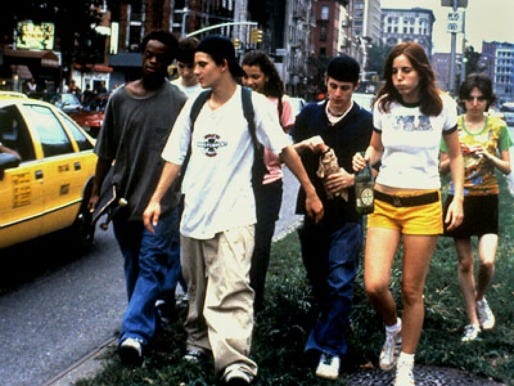Kids (1995)

Watching "Bully" was compelling enough to make me want to investigate the film oeuvre of director Larry Clark further, and I thought going back to his controversial debut movie, "Kids," was a logical choice.
Clark has an interesting biography for a filmmaker. He made his name as a photographer, specializing in lurid portraits of young (often underage) subjects engaged in drugs and sex. He made his first attempt at filmmaking in his early 50s, recruiting a 19-year-old skateboarder named Harmony Korine to bang out a script reflecting the wastrel lives of himself and his peers floundering around New York City.
(Korine has gone on to a fitful cinematic career of his own, recently directing "Spring Breakers.")
The cast was made up entirely of unknown amateurs, with two now-famous actresses making their debuts: Rosario Dawson and Chloe Sevigny. Both are vibrant presences in the film, especially Dawson, who comes off incredibly naturalistic and at ease.
Justin Pierce is also very good as Casper, though Leo Fitzpatrick is often leaden and unconvincing as Telly, the ostensible lead character. Other characters float in and out of the action, hanging out with Casper and Telly as they wander around the city, drinking, smoking dope, getting into fights and having indiscriminate sex.
The story unfolds on two separate tracks, initially divided by gender. Ruby (Dawson) and Jennie (Sevigny) talk boisterously with their girlfriends about their sexual escapades, while Telly, Casper and a bunch of guys do the same. It's both shocking and funny, listening to kids ranging from age 12 up to maybe 16 discuss things like blow jobs and anal sex.
We suspect that at least some of them are bluffing about their experiences, but we know Telly is not. The very first scene involves him convincing a 12-year-old girl to have sex with him. With his angular, scrawny body, crooked teeth and mushmouth speech, Telly does not seem like much of a Don Juan. But his specialty is enticing and deflowering very young virgins — of whom he then immediately disposes.
One of his conquests was Jennie, who never had sex before or since. Ruby, though, has had enough sexual partners to fill a lifetime, and she's worried about having AIDS. A flashback scene shows her getting tested at a local clinic a week earlier, with Jennie coming along for moral support, and getting tested while she's there. The Q&As with the clinic nurses are disturbing, both for the bored tone of the questioners and the shocking answers Ruby provides.
It's soon revealed that Ruby is OK, but Jennie is HIV positive. It's important to keep in mind that in 1995, having HIV was considered a virtual death sentence. The only question was how long you had to live.
Since Jennie only ever had sex with Telly, it stands to reason she got HIV from him — which also means his roving conquest of the city is exposing who knows how many very young girls to the disease. She sets off to find Telly and warn him, and especially any girls he might be wooing, of the danger.
Beyond this narrative thread, there really isn't much story in "Kids." Much like the early half of "Bully," Clark's camera just follows the kids around in a cinema verite style as they indulge in disturbing behavior. Indeed the film, which received an NC-17 rating from the MPAA, was perceived as a documentary by many audiences.
About that NC-17: The depictions in the film aren't really that outrageous other than showing underage characters having sex and doing drugs, though some of the actors were actually over 18. (Sevigny was 20 when the film was shot, but with her short blonde pixie cut, looks about 14.) Even though the actors are sometimes partially or fully undressed, Clark's camera carefully avoids showing breasts or genitals — unlike "Bully," which practically leers at its cast's young bodies.
Clark seems to have a fixation for a certain body type: extremely lean and hairless, stuck somewhere between adolescence and adulthood. The actors always look underfed, and it's notable that although we see them smoking and drinking up a storm, they hardly seem to eat at all. It seems likely that Clark's film contributed to the "heroin chic" look of the 1990s.
"Kids" is hardly a great piece of filmmaking, but several of the performances are standouts, and there's something strangely alluring about his rambling scenes of underage children sitting around, talking trash and getting high.
Clark seems to make no judgment about their bad behavior, merely depicting things going on around us that we'd rather pretend don't exist. Despite its rough edges, there is a vitality and immediacy to "Kids" that is potent and memorable.
3.5 Yaps



